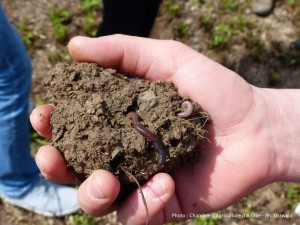Towards agricultural systems better able to withstand unexpected climatic events and preserve biodiversity?
8 septembre 2016Soil conservation agriculture, as has inspired the proven practices as part of Alister, is also beneficial for combatting erosion and lessening the impact of extreme weather phenomena.
![betterave Strip-Till[1]](http://www.grand-hamster-alsace.eu/wp-content/uploads/sites/9/2016/07/betterave-Strip-Till1-300x225.jpg) Recent weeks have given us a great deal of rain, floods and mudslides. It is now accepted that these sudden heavy downpours are the consequence of climate change and that they will become more numerous in the future, so tomorrow’s agriculture must reach a compromise with this new state of affairs.
Recent weeks have given us a great deal of rain, floods and mudslides. It is now accepted that these sudden heavy downpours are the consequence of climate change and that they will become more numerous in the future, so tomorrow’s agriculture must reach a compromise with this new state of affairs.
Technical solutions are gradually implemented by farmers supported by the chamber of agriculture, in the areas more sensitive to erosion of the mountain slopes of the Alsace:
- firstly, creating ‘physical’ barriers against run-off: planting hedges and setting up fascines**, NFIC*, and suitable positioning based on channels made by running water, and winter crops that cover the soil in spring.
Overhead obstacles interrupt or slow down streams of water and landslides; the root system of plants strengthens the soil structure, which retains the earth better. The covers and growing crops play this dual role, while feeding life in the soil, particularly earthworms that play an important role in the way it works. - secondly, improvement to the soil structure, by using reduced soil-working techniques: strip-till, surface soil working, direct sowing without working the soil (no-till farming).
Reduced working of the soil increases the amount and variety of life in and on the soil (bacteria, fungi, worms, etc.); their physical action (such as earthworm galleries) will improve soil porosity and structure, and allow faster drying. Improving the amount of organic matter in the soil also improves its consistency by boosting the clay-humus complex, which intimately associates the organic and mineral fractions of the soil.
 The conservation agriculture techniques are developing today in France, but are a technical break with traditional practices and generally need to be pursued for several years to be controlled.
The conservation agriculture techniques are developing today in France, but are a technical break with traditional practices and generally need to be pursued for several years to be controlled.
They should prove more resilient*** against unexpected climatic events, but probably also more favourable to diversity.
With this aim of preserving biodiversity, the LIFE Alister project has been testing techniques of this type for two years: reduced soil working by strip tillage and direct sowing; semi-permanent soil coverage using combined crops and early planting of NFIC*, etc.
*NFIC: Nitrogen-Fixing Intermediate Crops, plant ground cover sown during the period between two commercial crops.
** fascine: brushwood bundle
*** resilience: Ability of a system to absorb a disturbance, to be reorganised and to continue working in the same way as before




